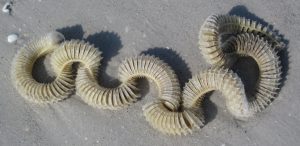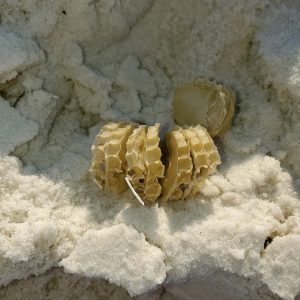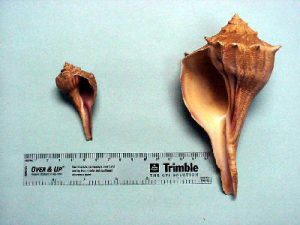
The text came through on a late May afternoon—a college friend was camping at Ft. Pickens with her kids. They’d spent the afternoon beachcombing and were curious. Her text read, “Here is your marine biologist question of the day…what is this? The discs appear to be connected like a vertebrae on a spinal cord. But it looks more like some egg casing…” Upon receiving her photos, I laughed to myself. She had no idea I have been writing this weekly column, but her question (and the hundreds like it I’ve had over the years) is exactly why I write it. Turns out, her observations were quite astute. The long, spiraling series of discs was indeed an egg case. These belong to a carnivorous whelk, most likely the lightning whelk Busycon pulleyi.

Adult whelks lay eggs during the late spring in a connected series of 50-175 disc-shaped capsules. The string of capsules can be more than 2 feet long, and each disc may contain up to 200 eggs. Due to their long, curling shape, these interesting finds have been nicknamed “mermaid’s necklaces.” Usually only a portion of the eggs in each capsule hatch. While in the capsules, the eggs mature through all their larval stages. If you pick up an intact capsule, you can often hear a rattle and see small dark shapes inside the capsules. When held up to the sun, you can see miniature, nearly microscopic baby whelks through the translucent capsule. Typically sometime in May, the tiny whelks will use an “escape hatch” to exit the capsules and enter the open sea. Historical records indicate early sailors used the long whelk cases as sponges; their rough but flexible edges are similar to natural sponges.
Carnivorous behavior starts early in the whelk world; hatchlings will feed on their unhatched whelk egg brethren. Adult whelks feed on bivalves like scallops, clams, and oysters, using the edge of their own shell to pry open the bivalve’s shell. A whelk may also attack prey by using its shell to grind open a hole in the bivalve shell and suck out the soft-bodied contents using its radula, a tonguelike organ with a toothed edge.

Beachcombers are just as likely to find a hermit crab inside a lightning whelk shell as the actual snail. They usually have brown lightning-shaped stripes down their shells, hence the common name. Lighting whelks are also considered rare “left-handed” molluscans, in that their spiral twists counterclockwise. If you were to insert your four fingers into the shell opening, your left hand would fit with the shell upright. Several Native American tribes ascribed fascinating spiritual significance to this left-handed spiral, but the shells were also utilized for daily functions as cups, bowls, and scrapers. “Right-handed” shells have the opposite shape and this differentiation can be used when identifying mollusks.
Lightning whelks live in the shallows of the Gulf of Mexico, or in open sand near seagrass meadows in bays. They are considered the “state shell” of Texas and are common from Texas beaches east along the northern Gulf and up the Atlantic coast to North Carolina.
 12
12
